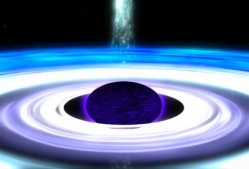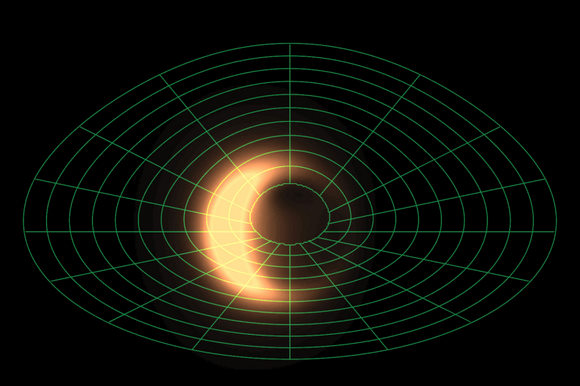[/caption]
An international team of astronomers has obtained the closest views ever of what is believed to be a super-massive black hole at the center of the Milky Way galaxy. The astronomers linked together radio dishes in Hawaii, Arizona and California to create a virtual telescope more than 2,800 miles across that is capable of seeing details more than 1,000 times finer than the Hubble Space Telescope. The target of the observations was the source known as Sagittarius A* (“A-star”), long thought to mark the position of a black hole whose mass is 4 million times that of the sun.
Using a technique called Very Long Baseline Interferometry (VLBI), the astronomers studied the radio waves coming from Sagittarius A*. In VLBI, signals from multiple astronomy telescopes are combined to create the equivalent of a single giant telescope, as large as the separation between the facilities. As a result, VLBI yields exquisitely sharp resolution.
They detected structure at a tiny angular scale of 37 micro-arcseconds – the equivalent of a baseball seen on the surface of the moon, 240,000 miles distant. These observations are among the highest resolution ever done in astronomy.
“This technique gives us an unmatched view of the region near the Milky Way’s central black hole,” said Sheperd Doeleman of MIT, first author of the study that will be published in the Sept. 4 issue of the journal Nature.

Though Sagittarius A* was discovered three decades ago, the new observations for the first time have an angular resolution, or ability to observe small details, that is matched to the size of the black hole “event horizon” — the region inside of which nothing, including light, can ever escape.
With three telescopes, the astronomers could only vaguely determine the shape of the emitting region. Future investigations will help answer the question of what, precisely, they are seeing: a glowing corona around the black hole, an orbiting “hot spot,” or a jet of material. Nevertheless, their result represents the first time that observations have gotten down to the scale of the black hole itself, which has a “Schwarzschild radius” of 10 million miles.
The concept of black holes, objects so dense that their gravitational pull prevents anything including light itself from ever escaping their grasp, has long been hypothesized, but their existence has not yet been proved conclusively. Astronomers study black holes by detecting the light emitted by matter that heats up as it is pulled closer to the event horizon. By measuring the size of this glowing region at the Milky Way center, the new observations have revealed the highest density yet for the concentration of matter at the center of our galaxy, which “is important new evidence supporting the existence of black holes,” said Doeleman.
“This result, which is remarkable in and of itself, also confirms that the 1.3-mm VLBI technique has enormous potential, both for probing the galactic center and for studying other phenomena at similar small scales,” said co-author Jonathan Weintroub.
The team plans to expand their work by developing novel instrumentation to make more sensitive 1.3-mm observations possible. They also hope to develop additional observing stations, which would provide additional baselines (pairings of two telescope facilities at different locations) to enhance the detail in the picture. Future plans also include observations at shorter, 0.85-mm wavelengths; however, such work will be even more challenging for many reasons, including stretching the capabilities of the instrumentation, and the requirement for a coincidence of excellent weather conditions at all sites.


Fat chance, the LHC will eat us all first
Wow! I remember hearing about this work back in 2003 when I was just learning about VLBI. I’m so excited that they actually did it!
Figuring out of black holes exist or not would be a great leap also.
Getting an image of the black hole would be a huge leap in astronomy.
yeah, i totally agree. Where is the image of the super-massive black hole?
I really hope we’ll have at least one radio disk on the Moon in my time (and I’m only 31 …).
And please to be using kilometres.
This is only inevitable outcome of the search for the closest SMBH to the solar system. Earlier papers alluded to the presence of an unusually dense object at the position of Sag A*, & soon some of our Earth-based observatories tied to the same insecapable conclusion, that a SMBH (currently relatively-inactive) resides at the core of our MWG. Increased resolutions with next-gen telescopes will lead to an increased understanding of condensed matter physics in our own local galaxy.
Jon are u just now getting this info?
Great work. I can’t wait until high-resolution observations of this enigmatic region become routine…
good job
Yes imaging the black hole “any black hole” would indeed be impressive!
Recently, on a 27th of August article, Nancy Atkinson reported on a US TV show called “Mythbusters”: “Some folks who lived through the 1960’s never believed the moon landings actually happened, and some how this belief persisted.”
My suggestion is to use Very Long Baseline Interferometry to end this rubbish, because due to this article earthbound VLBI could indicate objects the size “of a baseball seen on the surface of the moon, 240,000 miles distant.”
But the discarded metal left behind on the Apollo landing sites is much larger in size than baseballs. Why could we not picture them with VLBI?
Are sophisticated and well equiped amateur astronomers capable manage a worldwide project like “Amateur’s Very Long Baseline Interferometry”?
Could such a project not give amateur astronomy a complete new meaning? And the masterpiece, the first proof of it’s capability, could be the ultimate falsification of the conspiracy theory about the landings on the moon by producing photos of the abandoned lunar rovers and the landing modules.
Due to the global commercial communication networks everyone can synchronize any equipment with anybody’s devices elsewhere worldwide.
Very cool article. “A-Star” is only 10 million miles across at a distance of 30,000 light years. That is indeed, great resolution.
Think of the resolution we could get when we put a radio telescope on the Moon!
Nice idea Dollhopf – amateur VLBI tied by GPS signals seems cool. Anyone have any thoughts on whether this is feasible? Wonder what sort of precision could be achieved?
Bravo! Now to get a VLBI established here in Australia, beneath the very stary sky.
Ours will have to be a Federal Government & its CSIRO funded and run affair. Corporate involvement does not happen until the money comes in, and the corporations can get some.
I am sure that details on the Moon will follow. Ditto Mars and anywhere else. The focus is so tight, but computors can now do so much.
Go to, and make it so.
Hey.. Awesome blog.. but can you make the RSS feeds deliver entire posts?? would love to read full posts in my feed reader. Thanks..
amateur VLBI tied by GPS signals seems cool
Obviously I’m not an astronomer, and a *real* astronomer may chip in on this question, but in case they don’t:
I don’t believe that GPS accuracy alone is sufficient to be able to construct an amateur VLBI instrument. In order to construct a VLBI instrument the relative positions of the components has to be known to an accuracy that’s close to the wavelength of that you are observing in. Even for VLBI radio astronomy that means you need an accuracy down to millimeters.
As for using this VLBI technique to ‘see’ the moon landers: Remember these observations were done using RADIO waves (1.3mm wavelength if I read the article correctly). AFAIK the moon landers are not significant radio sources.
Congratulations, Nancy, on adding the comment “The concept of black holes, objects so dense that their gravitational pull prevents anything including light itself from ever escaping their grasp, has long been hypothesized, but their existence has not yet been proved conclusively.”
The original Harvard Smithsonian press release did not contain such a properly nuanced statement.
I wonder if that glow around the SMBH is gravitational lensing of objects on the other side…
dollhopf…
Radio astronomy doesn’t work with the visual light area of the spectrum, so it isn’t possible. Throwing radio waves at it in order to get “reflective” waves back would only show it as part of the moons background, due to the size of the items left behind.
Nothing will quiet the sceptics unless they are on the moon touching it for themselves, since any picture made available would be classified as “photo shopped”.
For information on how radio astronomy works go to: http://www.nrao.edu/index.php/learn/radioastronomy
This is a really fascinating way of looking at the universe, since it opens up different way to see things which are not normally visible or things which are obscured by dust!
Aodhhan, thank you for the clarification.
I somewhat must have been off my trolley this morning while I read this article.
Prediction.
They will discover that it is not a Super Massive Black hole at the center of our galaxy.
This will be born out by detection of material within the “event horizon”.
Also there should be evidence of clusters of objects way too close to the “event horizon”. They should of been “sucked in”.
Also the doppler shifts of radiation from many objects will be “off”. Instead of longer red shifts due to velocity of objects “falling” into the “supermassive black hole”, there will be a mix of redshifts in both directions.
The cores of galaxes are where matter continues to stream into our Universe.
Since this appears to be the first time this procedure has been used at this scale, why not do it for an object a bit closer and more well known? Then the data from Sagittarius A may have been a bit easier to interpret…
I assume from the various simulations I’ve seen and this one as well that a black hole, when eventually verified by optical means, will stand out as a huge shadow blocking light emitted by background objects. Is this so? Does the event horizon accumulation of matter of black holes yiedl some sort of disc around them, sort of like rings around an onyx Saturn; or would the black hold be completely surrounded by a halo of superheated matter and appear more as a slurpy plasma globe trailing wisps. Though a novice in these matters, it seems both might be possible, depending on whether the black hole is or is not spinning.
I find it funny that people are flipping out over “the equivalent of seeing a baseball on Earth, from the moon” as being technology advanced.
I can’t wait until I’m old and grey, and look back at this, and just laugh.